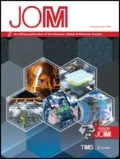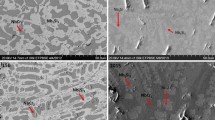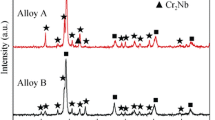Abstract
Nb-20Mo-15Si-5B-20Cr alloy has been oxidized in air in a range of temperatures from 700 to 1,300°C. A 24 hour exposure to air shows a minimum in weight gain per unit area at 900 and 1,000°C. Below and above this temperature the alloy has an oxide scale composed of oxide-metal interface which has been characterized by x-ray diffraction, scanning electron microscopy, energy dispersive spectroscopy, and x-ray mapping. Formation of CrNbO4 appears to be beneficial for the oxidation resistance while another Cr oxide, Cr2O3, may form mainly at temperatures below 1,000°C. SiO2 formation has been restricted to temperatures above 1,000°C. Long term oxidation consisting of seven successive 24 hour cycles of heating shows better oxidation resistance at 1,300°C for times longer than 96 hours but below that usual lower weight gain per unit area at lower temperature has been observed.
Similar content being viewed by others
References
M.D. Moricca and S.K. Varma, “The High-Temperature Oxidation Characteristics of Alloys from the Nb-W-Cr System with C Additions,” JOM, 60(7) (2008), pp. 66–69.
M.D. Gonzalez and S.K. Varma, “Oxidation Behavior of Alloys from the Nb-W-Cr System Containing C Modifiers,” Supplemental Proceedings: Volume I: Materials Processing and Properties (Warrendale, PA: TMS, 2008), pp. 455–460.
B.P. Bewlay et al., “A Review of Very-High-Temperature Nb-Silicide-Based Composites,” Metall. Mater. Trans. A., 34A (2003), pp. 2043–2052.
J. Geng, P. Tsakiropoulos, and G. Shao, “Oxidation of Nb-Si-Cr-Al in situ Composites with Mo, Ti and Hf Additions,” Mater. Sci. Eng. A., 441 (2006), pp. 26–38.
B.P. Bewlay et al., “Ultrahigh-Temperature Nb-Silicide-Cased Composites,” MRS Bulletin, 28(9) (2003), pp. 64–653.
T. Murakami et al., “Oxidation Resistance of Powder Compacts of the Nb-Si-Cr System and Nb3Si5Al2 Matrix Compacts Prepared by Spark Plasma Sintering,” Intermetallics, 9 (2001), pp. 629–635.
T. Murakami, S. Sasaki, and K. Ito, “Oxidation Behavior and Thermal Stability of Cr-doped Nb(Si,Al)2 and Nb3Si5Al2 Matrix Compacts Prepared by Spark Plasma Sintering,” Intermetallics, 11 (2003), pp. 269–278.
J. Doychak and M.G Hebsur, “Protective Al2O3 Scale Formation on NbAl3-Base Alloys,” Oxidation of Metals, 36(1) (1991), pp. 113–141.
J.-C. Zhao, M.R. Jackson, and L.A. Peluso, “Determination of the Nb-Cr-Si Phase Diagram using Diffusion Multiples,” Acta Materialia, 51 (2003), pp. 6395–6405.
J. Geng, P. Tsakiropoulos, and G. Shao, “The Effects of Ti and Mo Additions on the Microstructure of Nb-Silicide Based in situ Composites,” Intermetallics, 14 (2006), pp. 227–235.
J. Ventura, B. Portillo, and S.K. Varma, “Oxidation Resistant NbCr2 Phase in Nb-W-Cr System,” J. Alloys and Compounds, 476(1–2) (2009), pp. 257–262.
K.S. Chan, “Cyclic Oxidation Response of Multiphase Niobium-Based Alloys,” Metall. Mater. Trans. A., 35A (2004), pp. 589–597.
K. Chattopadhyay, R. Mitra, and K.K. Ray, “Nonisothermal and Isothermal Oxidation Behavior of Nb-Si-Mo Alloys,” Metall. Mater. Trans. A., 39A (2008), pp. 577–592.
M.G. Mendiratta, T.A. Parthasarathy, and D.M. Dimiduk, “Oxidation Behavior of αMo-Mo3Si-Mo5SiB2 (T2) Three Phase System,” Intermetallics, 10 (2002), pp. 225–232.
M. Akinc et al., “Boron-Doped Molybdenum Silicides for Structural Applications,” Mater. Sci. Eng. A, A261 (1999), pp. 16–23.
V. Behrani et al., “Microstructure and Oxidation Behavior of Nb-Mo-Si-B Alloys,” Intermetallics, 14 (2006), pp. 24–32.
Y. Liu et al., “Oxidation Behavior of Multiphase Nb-Mo-Si-B Intermetallics,” Metall. Mater. Trans. A., 36A (2005), pp. 601–607.
“Molybdenum and Molybdenum Alloys,” Kirk-Othmer Encyclopedia of Chemical Technology, 27 volume set (5th edition) (New York: John Wiley & Sons, 2004).
W. Semmel, Jr., “The Oxidation of Tungsten and Molybdenum from 1800 to 2500°F,” High Temperature Materials Conference, Cleveland, OH (New York: John Wiley & Sons, Inc., 1959), pp. 510–519.
Sylvia Nativadad et al., Proc. of International Conference on Processing and Manufacturing of Advanced Materials—Thermec’2009 (Berlin, Germany, 25–26 August 2009).
Author information
Authors and Affiliations
Corresponding author
Rights and permissions
About this article
Cite this article
Ventura, J., Varma, S.K. The oxidation resistance of Nb-20Mo-15Si-5B-20Cr up to 1,300°C. JOM 61, 72–75 (2009). https://doi.org/10.1007/s11837-009-0108-5
Published:
Issue Date:
DOI: https://doi.org/10.1007/s11837-009-0108-5




